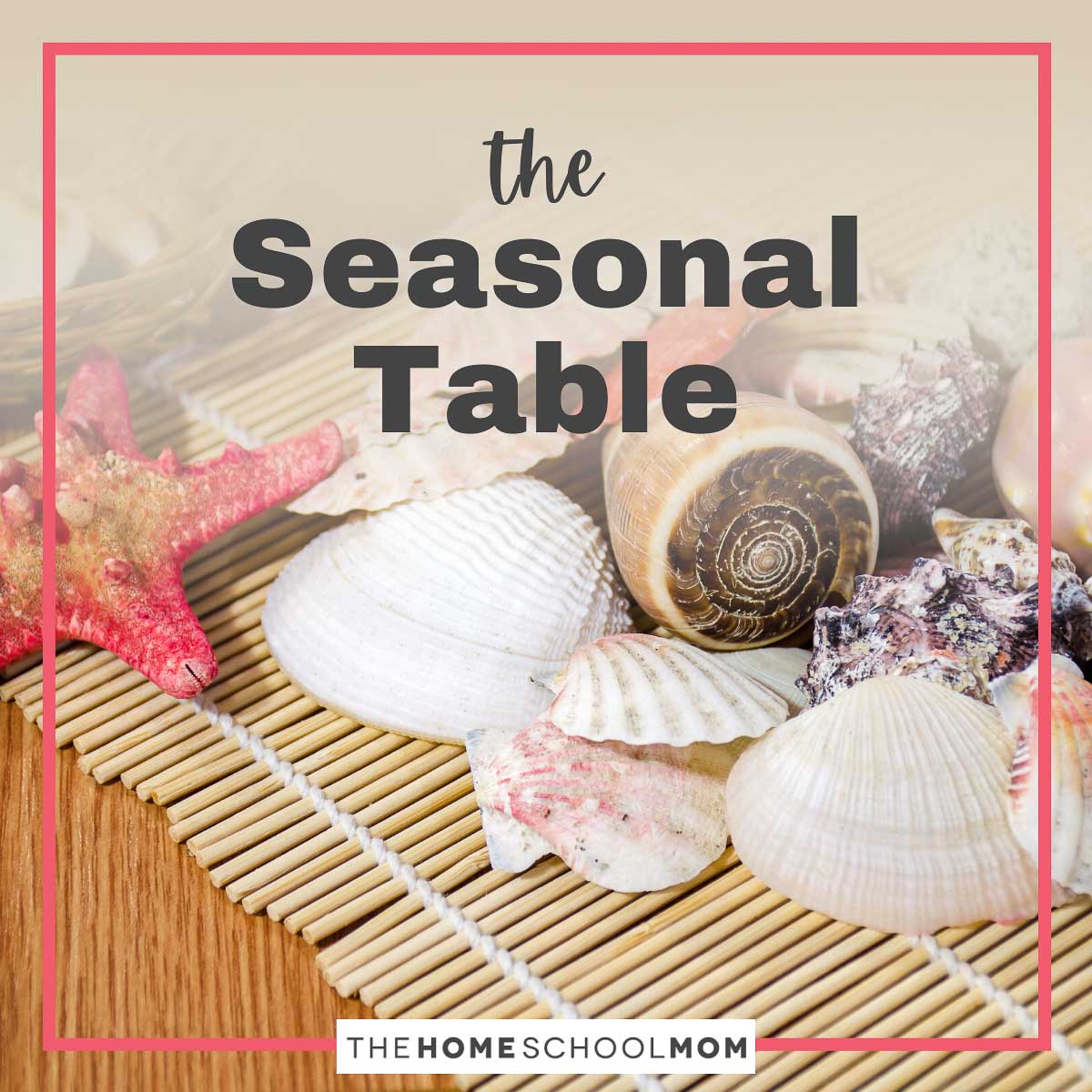Charming seasonal nature tables, commonly enjoyed in homes of Waldorf-inspired homeschoolers, are a great way to bridge the gap between indoors and outdoors.
Waldorf nature tables keep kids in touch with nature and the outdoor world, and they will bring some field-and-forest beauty into your home.

For All Kinds of Homeschoolers
Sometimes we have had a designated nature table, something which is suggested by both the Waldorf-inspired approach and the Montessori-inspired approach to homeschooling, and something many Charlotte Mason homeschoolers implement as well.
Other times, we have just gathered seasonal treasures together as a kitchen table centerpiece.
Children enjoy taking a dedicated nature walk with a basket to carry treasures found along the way.
It's important to note that some nature finds are precious or protected by law. For example, don't remove or move nests birds may use again; in fact, don't disturb any nesting or hibernating animals to try to gather something from nature. Remember some state and national parks prohibit taking natural items out of the park. Make it a point to learn about protected and precious nature items.
For Each Season of the Year
Our Waldorf winter nature table might feature pinecones and bright red berries. In spring, a few feathers, some bright green leaves and grasses, blue pieces of a hatched robin's egg.
The summer nature table might include some smooth round river rocks and Queen Ann's lace.
On an autumn day, our nature table might include gourds from the garden, red and yellow leaves, acorns gathered under the oak trees, and cattails or dried seed pods.
Today I arranged the finds in a bowl that one of my sons made a few years ago, a yellow and black fused glass piece whose colors work well with autumn finds. I guess you'd say I'm comfortable with a lack of sophistication-I'm happy to have hand-strewn leaves under and around the bowl of gourds for added color and texture.
To complete today's centerpiece, I added a candle in a candle holder that another of the kids created at a craft night at scouts quite a few years ago. He had glued varying colors of tissue paper to a glass jar, and the light from the candle glows through the translucent paper.
The memento has aged well, and if anything, the slight yellowing of the tissue paper makes it blend even better with the golds of the leaves and browns of the stems brought in from the woods.
Each arrangement brings a sense of the seasons, giving young children some iconic symbols of the ripening year.
For Curiosity
Older children take an interest in the "what" of the seashell or snakeskin (yes!), and I keep field guides and a magnifying glass nearby for impromptu identification sessions. Nature apps are also a useful resource for identification.
For Ambience
One of the best things about creating a seasonal table is that gathering and placing the chosen items is a special occasion. Even a terrible, horrible, no good, very bad day can be rescued with, "I know-let's re-do the table today!"
A walk in the brisk air, the scavenger hunt for natural objects that are lovely to see and touch and smell and shake, the artful arranging and rearranging of the bounty-these refresh the senses and clear the cobwebs out of minds.
And it's interesting how, once freshly adorned, the table is a lovely place for children to sit with a cup of tea with honey and their colored pencils, sketching whilst the candle burns and Mom reads aloud.
For An Essence of Education
Having a hand in gathering the items for the seasonal table and helping to arrange them is a small act of personal power for some kids, a spark of creativity for others, an act of beauty and civilization for others.
People try to identify why homeschooling works for so many families, and they point to curricula and test scores. For us, it is the walks in the woods, the leaves on the table, and the time and presence to talk about the thorns and thistles we gather.




 A popular speaker at homeschooling conferences, business groups, and parents’ groups, Jeanne Potts Faulconer homeschooled her three sons in North Carolina, Mississippi, and Virginia for twenty years. Holding her Master of Arts degree in Communication, Jeanne conducted portfolio evaluations for Virginia homeschoolers for evidence of progress for many years. Jeanne is a former college faculty member, former editor for several publications, news correspondent for WCVE, and former director of Brave Learner Home. She is the contributing editor for TheHomeSchoolMom newsletter and writes the popular Ask Jeanne column addressing homeschool parents' questions here at TheHomeSchoolMom.
A popular speaker at homeschooling conferences, business groups, and parents’ groups, Jeanne Potts Faulconer homeschooled her three sons in North Carolina, Mississippi, and Virginia for twenty years. Holding her Master of Arts degree in Communication, Jeanne conducted portfolio evaluations for Virginia homeschoolers for evidence of progress for many years. Jeanne is a former college faculty member, former editor for several publications, news correspondent for WCVE, and former director of Brave Learner Home. She is the contributing editor for TheHomeSchoolMom newsletter and writes the popular Ask Jeanne column addressing homeschool parents' questions here at TheHomeSchoolMom.
What a great idea! We love nature walks. Now I know what to do with all the treasures we bring home. Than!k you for posting this!